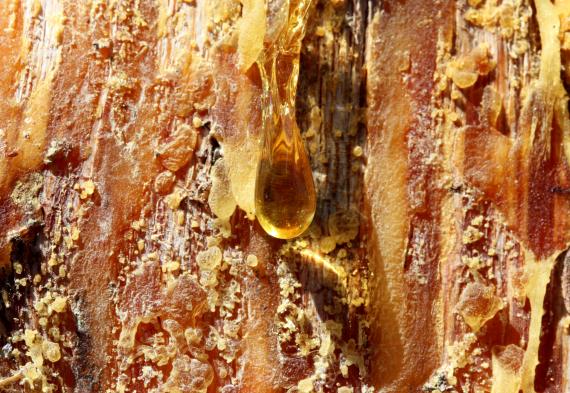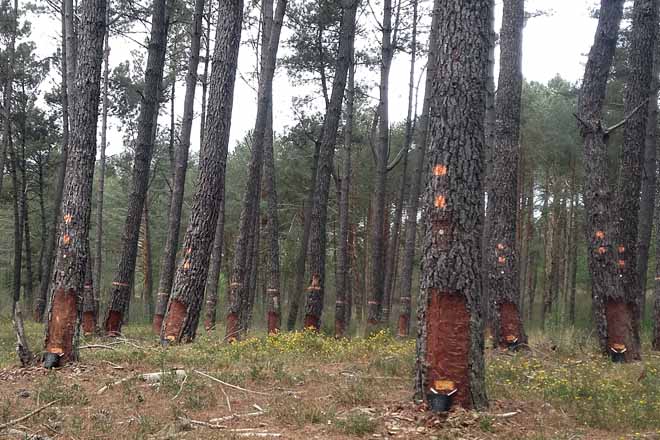
In the Spanish provinces of Segovia, Ávila and Valladolid a special treasure is hidden.
There, in the middle of Tierra de Pinares and Sierra de Gredos, a thick forest of 400,000 hectares of resinous pines extends towards the mountains.
Sheltered from the hot Spanish sun and lined with trails, this forest is a popular destination for locals and tourists. And, if you visit at the right time and look closely, you'll see workers standing by the tree trunks carrying out the centuries-old tradition of harvesting the "liquid gold" of the pine.

In Spain and much of the Mediterranean, pine resin was used to waterproof ships, treat burns, and light torches, among other things. But it was not until the 19th and 20th centuries that pine resin extraction became profitable in that Spanish region. When technology and industrialization helped convert the thick sap into plastics, varnishes, glues, tires, rubber and even food additives in the mid-19th century, the owners of the dense Pinus pinaster forests of Castilla y León saw an opportunity. And although this slow process stopped in much of the world, in the last decade it has experienced a renaissance in Castilla y León, the place with the most resin manufacturers in all of Europe and one of the last on the continent where this practice persists.
 The extraction process has remained largely unchanged since this industry began, but today's resin manufacturers have created more efficient and ergonomic tools, as well as chemicals that stimulate resin secretion. As a result, yields and productivity were greatly improved.
The extraction process has remained largely unchanged since this industry began, but today's resin manufacturers have created more efficient and ergonomic tools, as well as chemicals that stimulate resin secretion. As a result, yields and productivity were greatly improved.
What also changed was that in the past the extraction of resin was "to the death" of the trees, using very aggressive methods. But, for some time now there has been a change "to life", with a practice in which the number of incisions in the bark is minimized, reducing damage to the tree.
In the warmer months of March through November, local growers carefully extract the resin from the pine trees by first removing the outer layer of the tree's bark. They nail a holder and place a collection container. The extractors then use their axes to make diagonal incisions in the bark causing the trees to "bleed" and their resin to seep into the bucket. When they are full, they pour the sap into 200kg containers.
Producers send the substance to distilling factories, which extract the turpentine from the resin, which has a slimy, yellowish appearance that solidifies when cooled into shiny, amber-coloured stones. During the peak of pine resin extraction in Spain in 1961, when 55,267 tons were extracted, more than 90% came from the forests of Castilla y León. The lack of demand and the sharp fall in prices led to production falling and almost disappearing in the 1990s. Many thought that this would be the end of this Spanish tradition.



In Castilla y León, resin has not only been an economic livelihood for rural communities, but also a trade that is passed down from generation to generation. Many families have at least one person who has "bled" trees or participated in their distillation. Much of the economic and social activity in these towns has always been marked by the resin industry and the communities maintain this legacy as an important part of their culture.
Today we can see many products made from petroleum, such as plastic, for example, which is not biodegradable, can also be made from resin and break down more easily. Resin is thought to be the oil of the world today and in the future. The idea is that all uses of oil will be replaced by resin. Plastics are already being manufactured from resin. For example, in the cosmetic and pharmaceutical industry in addition to its applications in construction or in the manufacture of varnishes and glues. The forest is a great supplier of renewable resources and energy that it allows substituting petroleum products. Resin plays an important role. Pine resin advocates also believe it could offer a solution to Spain's rural exodus. According to a report by the Bank of Spain, 42% of the towns in the country are affected by depopulation because more and more young people are leaving the countryside to seek better job opportunities in the cities. This phenomenon is aggravated in Castilla y León, where 80% of the municipalities in 14 provinces are considered "in danger of extinction”. However, due to the new interest in pine resin, some young people have begun to return.


The Valle del Tiétar (Ávila) has recently applied to become a UNESCO-protected Biosphere Reserve with the intention of protecting the region. Additionally, to raise interest and attract tourism there are also several museums where visitors can see the traditional cabins where the first workers slept and appreciate old tools, and several companies offer guided tours of the "Ruta de la Resina”. On weekends, these lush forests can be filled with the sound of footsteps as tourists come to escape the hustle and bustle of nearby cities.